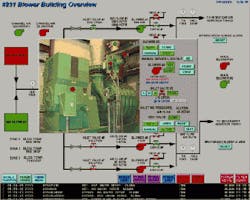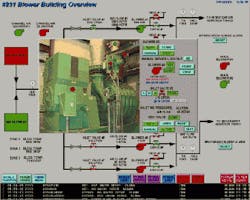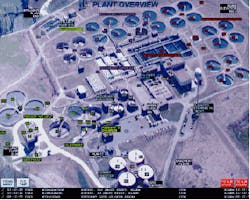City Turns to Off-the-Shelf Hardware, Software
By John Cowger and Greg Kuchy
Imagine a fully automated wastewater treatment facility that can awaken a supervisor during the night if a problem arises, present the supervisor with detailed information, and allow him to fix the problem from his home computer. Better yet, imagine constructing this system with off-the-shelf software and hardware. The Sanitary District of Decatur, Ill., has built such a system, which can serve as a model for small and large municipalities.
The Decatur Sanitary District serves a population of approximately 95,000 through one wastewater treatment plant with 28 outlying pump stations and four combined sewer overflow facilities. Nearly half of the flow to the facility is generated by industry. Although the treatment facility receives an average daily flow of approximately 32 mgd, the design capacity is 41 mgd. The plant has a hydraulic capacity of 125 mgd to accommodate flows during wet weather.
In the mid-1990s, the district was operating without a standard platform for technology and no unified strategy for adding new technologies. Most of the business processes were not automated, and those that were automated were not connected to each other. The control system consisted of nine different monitoring enclosures around the plant called Distributed Control Units (DCUs), which were tied back to two Distributed Control Operator Consoles (DOCs) by two redundant fiber optic communication highways. The control room housed two monitors that displayed a series of text and numbers requiring a combination of several keystrokes to switch from screen to screen.
All system changes had to be done in the control room, and operators had to remember which screen controlled a particular plant function and which key strokes were required to get to the relevant screen. The monitoring system was limited because the alarm display did not provide details on the nature of a problem. The multiple alarm points were not distinguishable, one from the other. As a result, when an alarm sounded, the operator could not diagnose or pinpoint the problem and so had to investigate in person. Often, the problem turned out to be so minor that the in-person visit was unnecessary and wasteful.
As a result, the district and ICCS, a unit of Woodard & Curran, developed a Technology Plan which sought to examine all of the district's existing systems and identify those that could be integrated to share information among departments. The plan defined the projects required to upgrade the system and facility, the budgetary cost of each project, and an implementation schedule.
The district's existing proprietary control system was replaced with a new Allen-Bradley PLC-based Supervisory Control and Data Acquisition (SCADA) system. The system's backbone is the Intellution Fix-Human Machine Interface (HMI) and SCADA software, which establishes a base on which other complementary computer applications can be integrated. The HMI piece of the software presents a graphical image of the plant processes, while the SCADA piece gathers the operational data and creates a historical archive of the information.
Before implementing specific computer applications, a Local Area Network (LAN) had to be designed and installed for the district's administration building. The LAN comprised Ethernet hubs, category five cables, and a centralized server running Microsoft NT Server software. Once the LAN was in place, all standardized PCs were connected to the network operating Microsoft Windows and Office applications. Next, the nine DCUs were replaced with nine PLCs tied back to two new operator interface computer SCADA nodes.
The HMI software presents the entire facility on the operators' monitors, allowing them to see which processes are linked together, and to navigate through the screens with a click of a mouse. The operators can monitor and remotely control all plant processes and equipment from the central station, as well as see detailed information on any problems that sound an alarm.
Although the new HMI/SCADA system represents the cutting edge of technology, building it did not break the bank. The district was able to project a list of hardware and software needs, then bid out the equipment to find the lowest prices. The district knows its needs and what the cost will be over the duration of the project, which makes developing annual budget requests much easier.
The system also saves money by saving time. The alarm management software monitors every alarm, process variable and event, then notifies all responsible parties and provides them with detailed information via telephone, pager, radio, email, fax, PA system, and PC workstation pop-ups. When a problem arises, the system detects the priority of the alarm for notification. If the situation escalates, the system continues notifying the responsible parties in the chain of command. As a result, response time is quicker and, when the operator arrives, the system has already provided details of the situation and what needs to be done.
The district also has installed Datastream MP2 Computerized Maintenance Management Software (CMMS). Although the CMMS is not currently online with the SCADA system, the district can generate preventative maintenance work orders based on a calendar system, rather than through the SCADA system. It can generate work orders, close work orders, open and close purchase orders, and track maintenance personnel to determine how they spend their time. As a result, the district has suffered fewer equipment failures and emergencies, saving time and money in repair costs. Once the CMMS System is online with the SCADA system, the district will be able to take real time SCADA information, such as pump run times, and automatically generate preventive maintenance work orders.
The district also has installed Laboratory Information Management System (LIMS) software to track and archive the district's information into a database where staff members can plot trends, enabling them to proactively manage the facility.
Further, all of the district's treatment plant HMI screens are on a web server, which allows staff members to view current plant conditions with a standard web browser. This places crucial real-time plant information into the manager's hands in a much more timely fashion. In addition, a few key managers have the ability to dial into the system to respond to emergencies and monitor the system from their homes. The district plans to have HMI screens for its outside facilities on the web server by 2002.
Conclusion
Wastewater treatment facilities are under increasing demands to produce higher quality effluent without also increasing operating costs. Building an HMI/SCADA system to run Decatur's sanitary district operations has greatly improved the district's operating efficiency, saving money and valuable man-hours. Because the entire system was built with off-the-shelf hardware and software, costs were kept down, allowing even the smallest municipality to use Decatur as a model for implementing its own SCADA system.
About the Authors: Greg Kuchy is the Director of Engineering for the Sanitary Department of Decatur, Ill. John Cowger is vice president for ICCS, a unit of Woodard & Curran. Tammy Doty of the ICCS unit of Woodard & Curran also contributed to this article.

